
Time to make some baby bunnies!
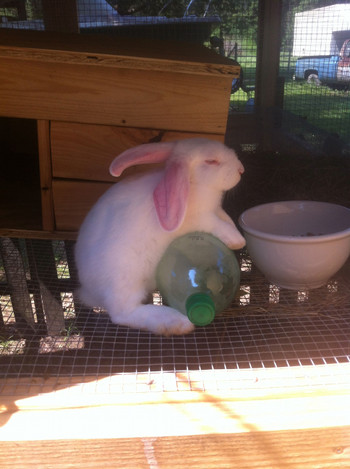 We started with our first
rabbit, a New
Zealand White, sometime during the late spring. (He's the one
in the picture to the right relaxing on a bottle of ice water during
our summer heat.) He was a young male that was purchased from a
local feed store and was the only meat rabbit they had left.
We started with our first
rabbit, a New
Zealand White, sometime during the late spring. (He's the one
in the picture to the right relaxing on a bottle of ice water during
our summer heat.) He was a young male that was purchased from a
local feed store and was the only meat rabbit they had left.
While we were searching out other available rabbits in the local area,
our new neighbors who had just moved in offered us a pair of New
Zealand Whites. The rabbits were apparently a gift for their son
but they weren't too keen on keeping them around. The rabbits
were both a bit older than our first rabbit, and I'd estimate they had
a full 6-8 weeks in age on our young buck. This turn of events is
how we ended up with two males and one female. Obviously not the
ideal mix of male-to-female ratio, but hey... two of them were
free.
When we discussed breeding,
we considered the possibility that the free pair from our neighbors
were likely closely related and possibly siblings. Some
literature Dawn read from the library actually encourages inbreeding of
rabbits, but that seems so counter to everything we have learned in the
past that we will likely shy away from that. So, we decided we'd
breed the storebought male with the donated female. Later we'll
find another female (possibly a Californian) to breed with our other
male. That will give us a 50/50 mix and two breeding pairs.
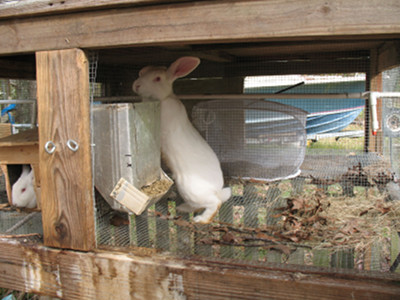 Sometime in the last month or two our
purchased male finally reached maturity, so the question became when
did we want to breed them and have our first litter arrive?
Ideally, we'd have the arrival timed when we are both around. I
travel a bit for work, and we didn't want to time it for when I'd be
gone. Also, we wouldn't want to time it during potential holidays
or vacation time (like our recent NC & VA trip when we visited
Anna & Mark). So, this past weekend ended up
being the "big date" for our rabbit pair, constrained by our schedules.
Sometime in the last month or two our
purchased male finally reached maturity, so the question became when
did we want to breed them and have our first litter arrive?
Ideally, we'd have the arrival timed when we are both around. I
travel a bit for work, and we didn't want to time it for when I'd be
gone. Also, we wouldn't want to time it during potential holidays
or vacation time (like our recent NC & VA trip when we visited
Anna & Mark). So, this past weekend ended up
being the "big date" for our rabbit pair, constrained by our schedules.
If all goes well, our doe will have a litter sometime around December
10th. I'm hoping that the entire process will be uneventful and
require little from us other than providing some bedding and cleaning
of the hutch. Cold weather might be a concern, but we'll see how
it goes. Winters are typically pretty mild around here and if we
have to we can insulate or heat the hutch. If we're lucky, the
weather will be fine and temperature will not be a concern.
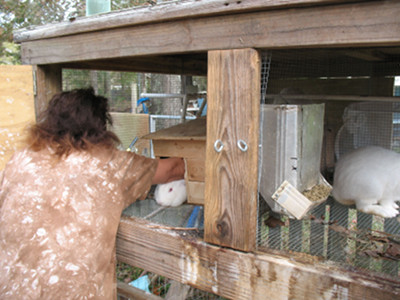 The process of breeding was
fairly uneventful. We rounded up the female, removed the box from
the male's hutch so that there'd be more room, and then placed the
female on his side. Generally, the female should always be
brought to the male. The other way around apparently can turn
violent as the female will often defend her turf.
The process of breeding was
fairly uneventful. We rounded up the female, removed the box from
the male's hutch so that there'd be more room, and then placed the
female on his side. Generally, the female should always be
brought to the male. The other way around apparently can turn
violent as the female will often defend her turf.
Female rabbits are reflexive ovulators and some of the reading that
Dawn has done suggests that they should be bred multiple times in the
course of a day or two. We tried this, but "date #2" didn't go as
well as the first time around. She wasn't having any of it the
second day, so we will see if this was a successful pairing or
not. When we first placed the female in the male's hutch, there
was a bit of chasing, but there was no fighting. We were a bit
concerned about whether or not there would be a battle but they seemed
to be pretty well behaved as they did what comes naturally.
One thing we will have to do
to prepare over the next couple of weeks is to modify the nesting box
so that it has a hinged top allowing access to the litter. Dawn
is the expert here as she's done all the reading on the topic.
She's also the one who built the boxes for our rabbits and probably
will be the one to modify the female's nesting box.
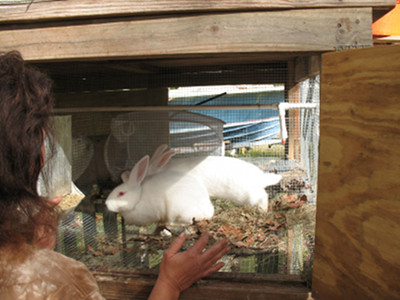 We'll need to decide quickly what
kind of nesting material we will place in the hutch. There are
several options; some are readily available materials (hay, grass,
leaves), while others are available commercially (bagged cellulose,
etc.) The literature claims that when she is preparing to have a
litter, the doe will use available nesting material and combine that
with fur which she pulls out of her coat. When cleaning the
netsting box they say to change the hay (or other material) and put the
fur back with new nesting material.
We'll need to decide quickly what
kind of nesting material we will place in the hutch. There are
several options; some are readily available materials (hay, grass,
leaves), while others are available commercially (bagged cellulose,
etc.) The literature claims that when she is preparing to have a
litter, the doe will use available nesting material and combine that
with fur which she pulls out of her coat. When cleaning the
netsting box they say to change the hay (or other material) and put the
fur back with new nesting material.
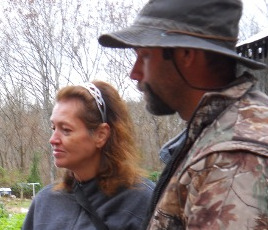 I'm sure we'll make some
discoveries along the way and will learn in the process. With any
luck, we'll have some cute bunny pictures to share soon. We've
just got to stay unattached to the cute fuzzballs so that we cannot
feel bad when it comes time to put them in the oven!
I'm sure we'll make some
discoveries along the way and will learn in the process. With any
luck, we'll have some cute bunny pictures to share soon. We've
just got to stay unattached to the cute fuzzballs so that we cannot
feel bad when it comes time to put them in the oven!
Shannon and Dawn
will be sharing their experiences with raising meat rabbits on Tuesday
afternoons. They homestead on three acres in Louisiana when time
off from life and working as a sys admin permits.